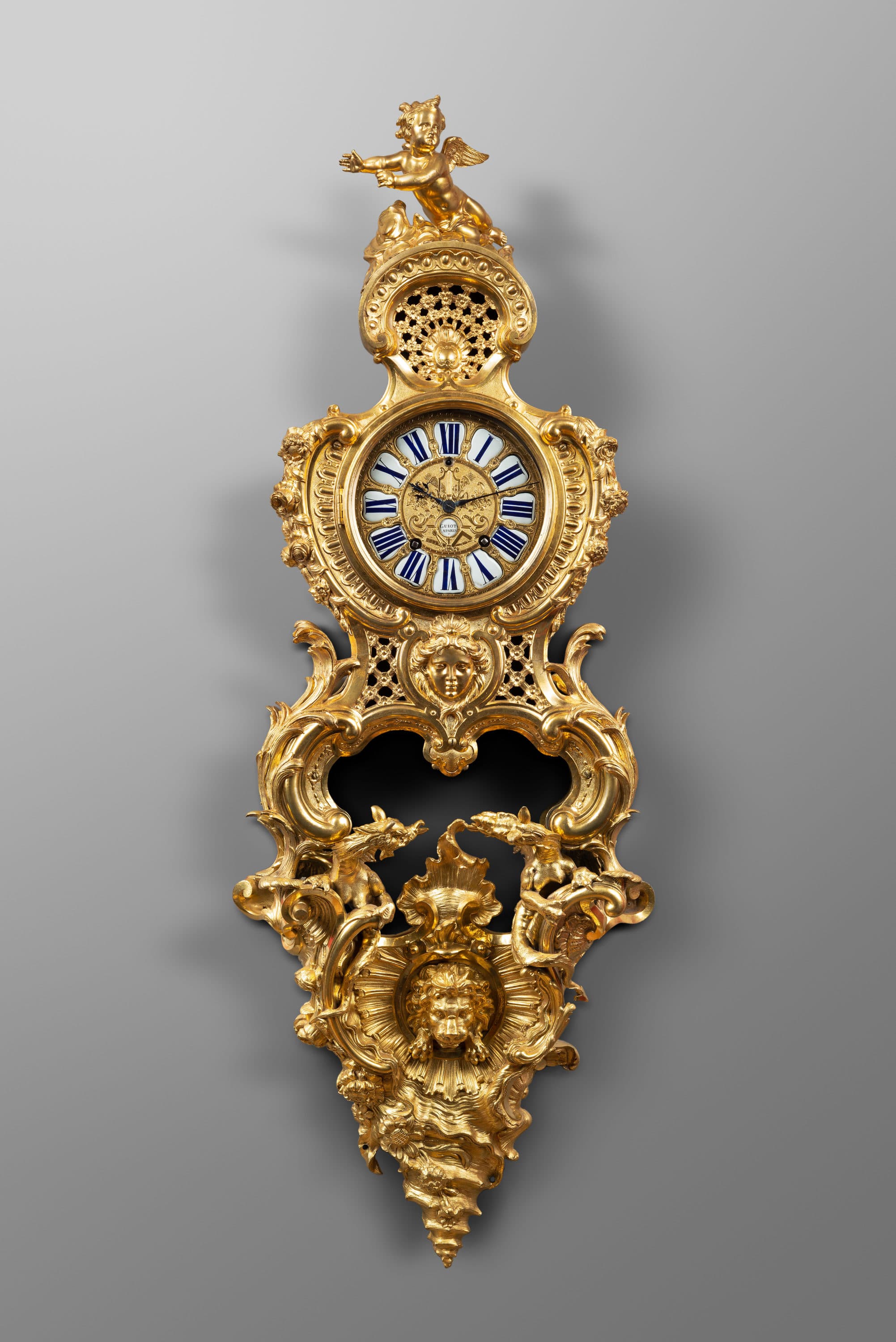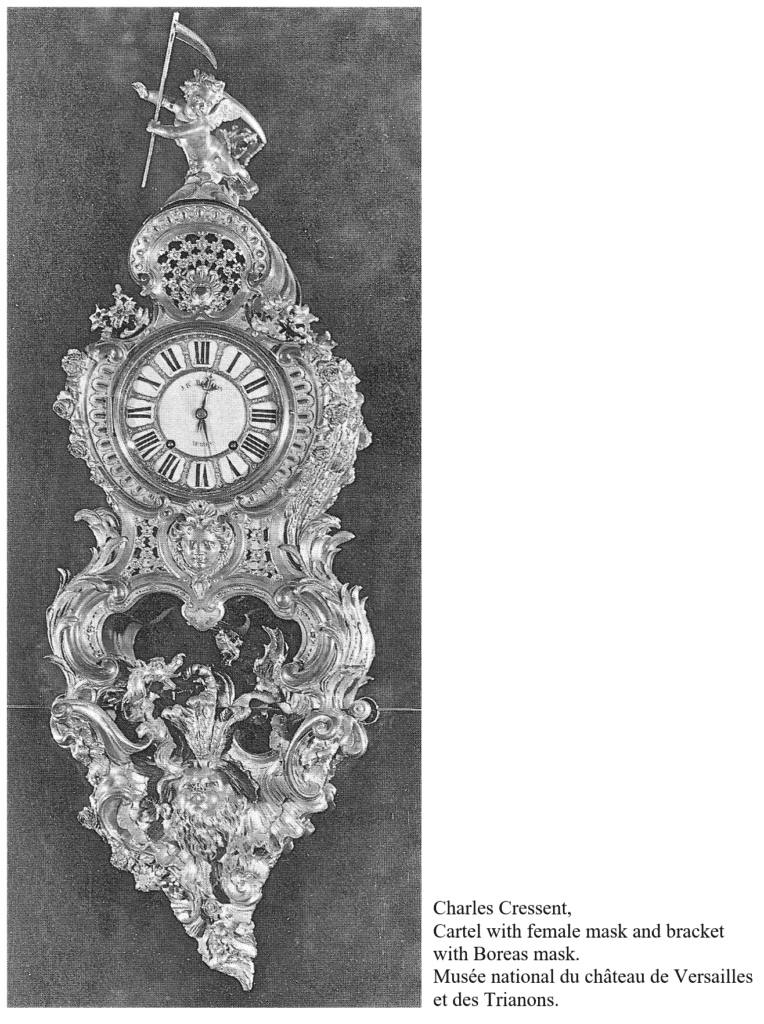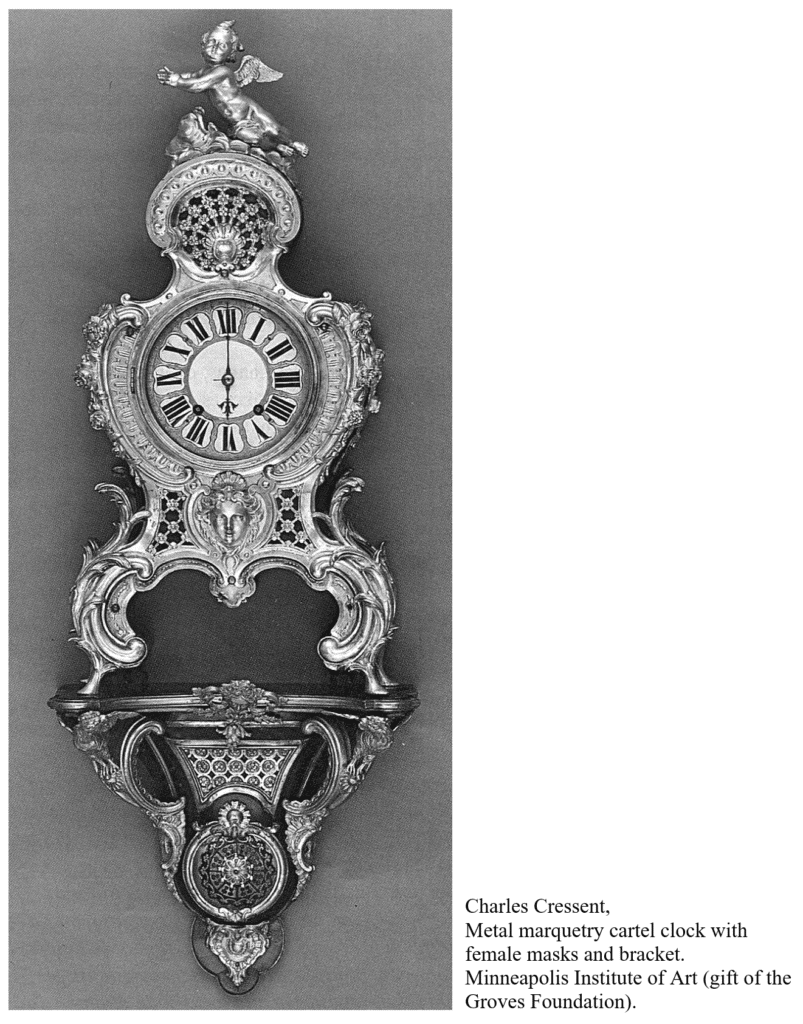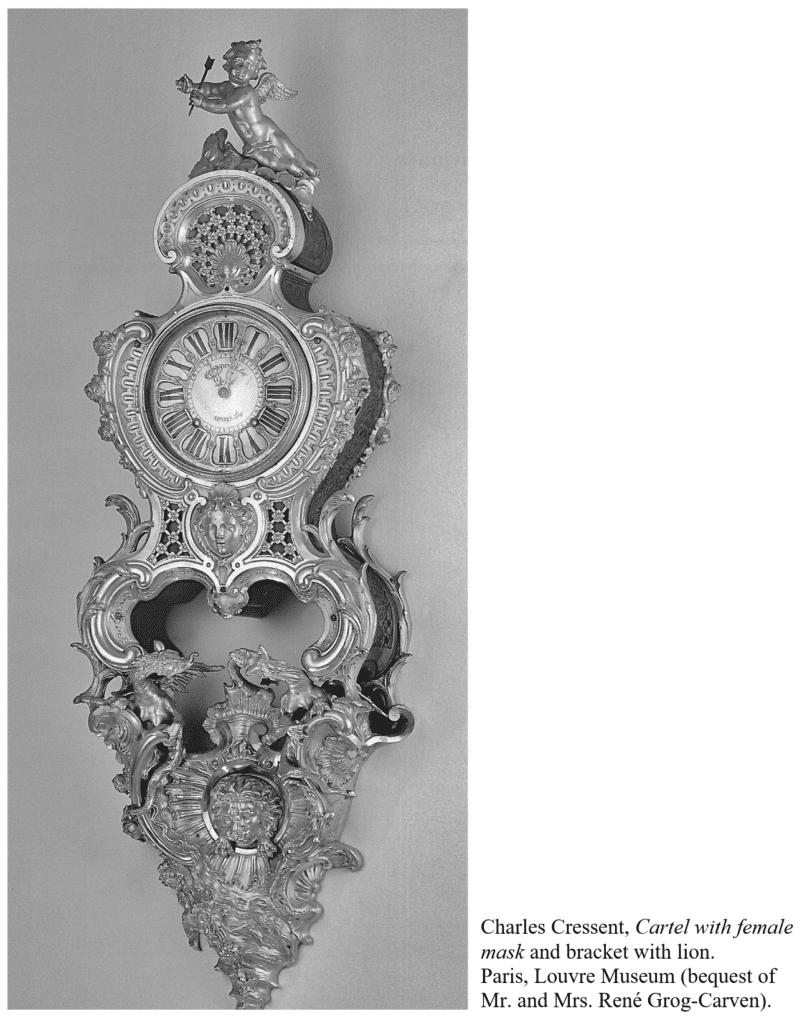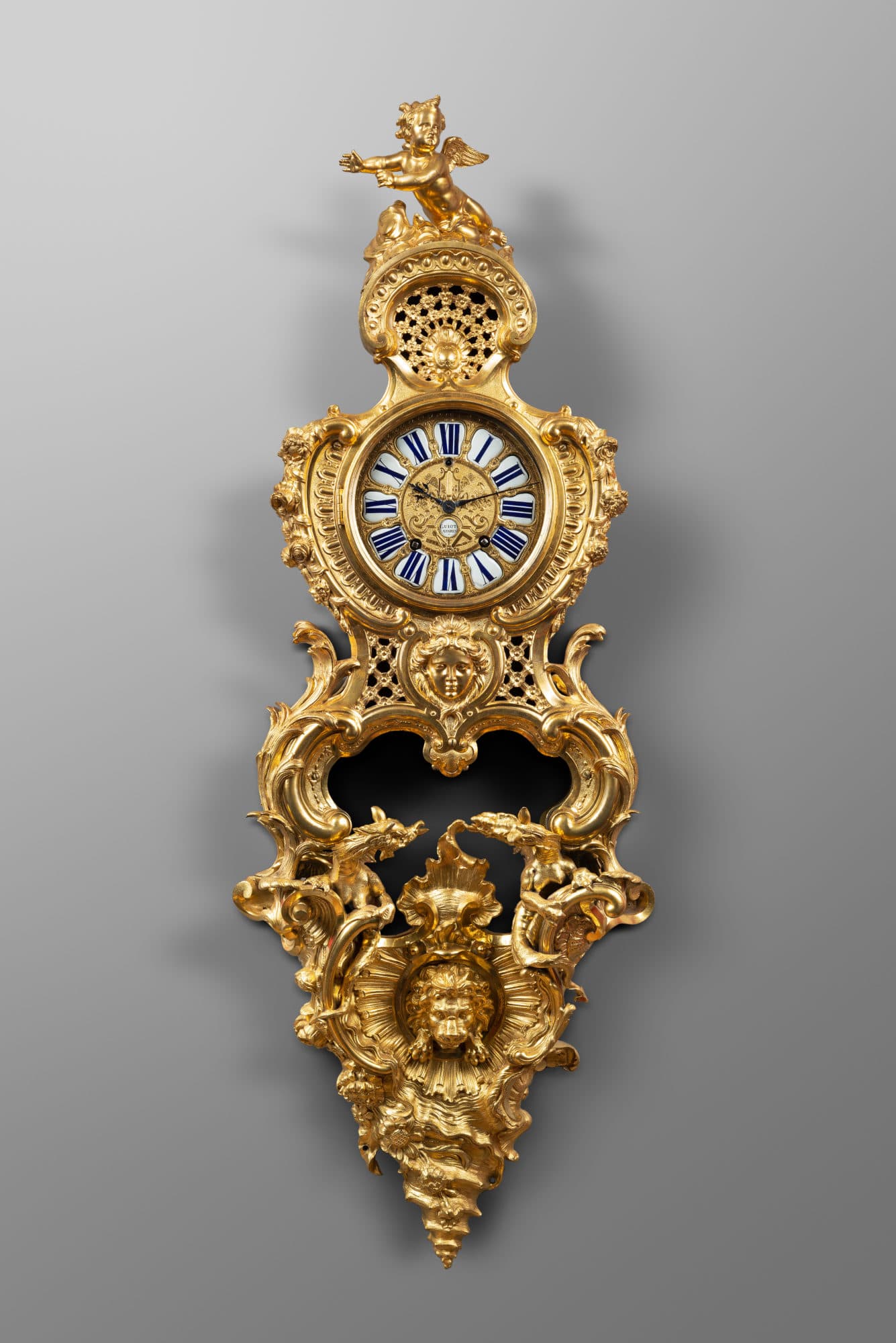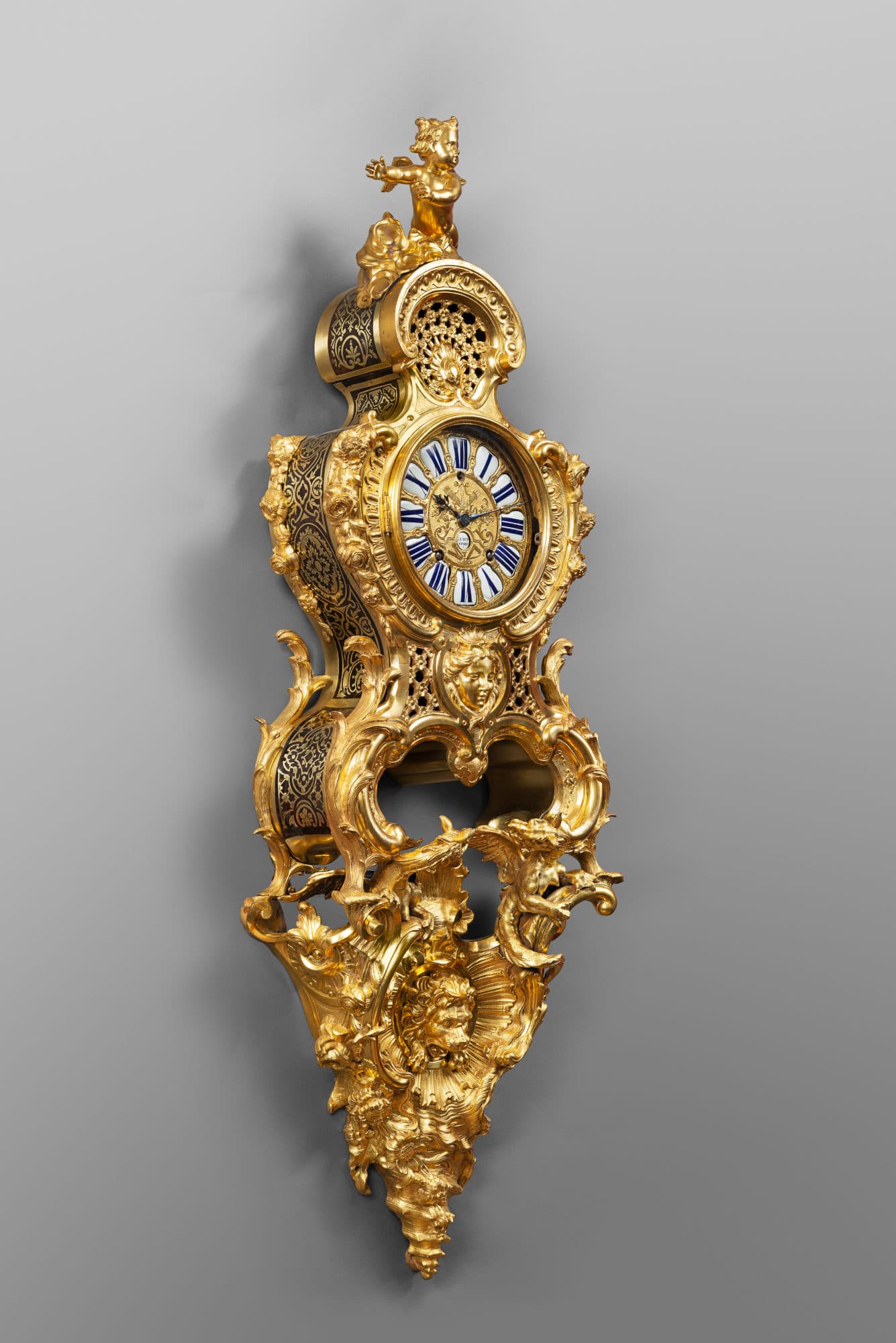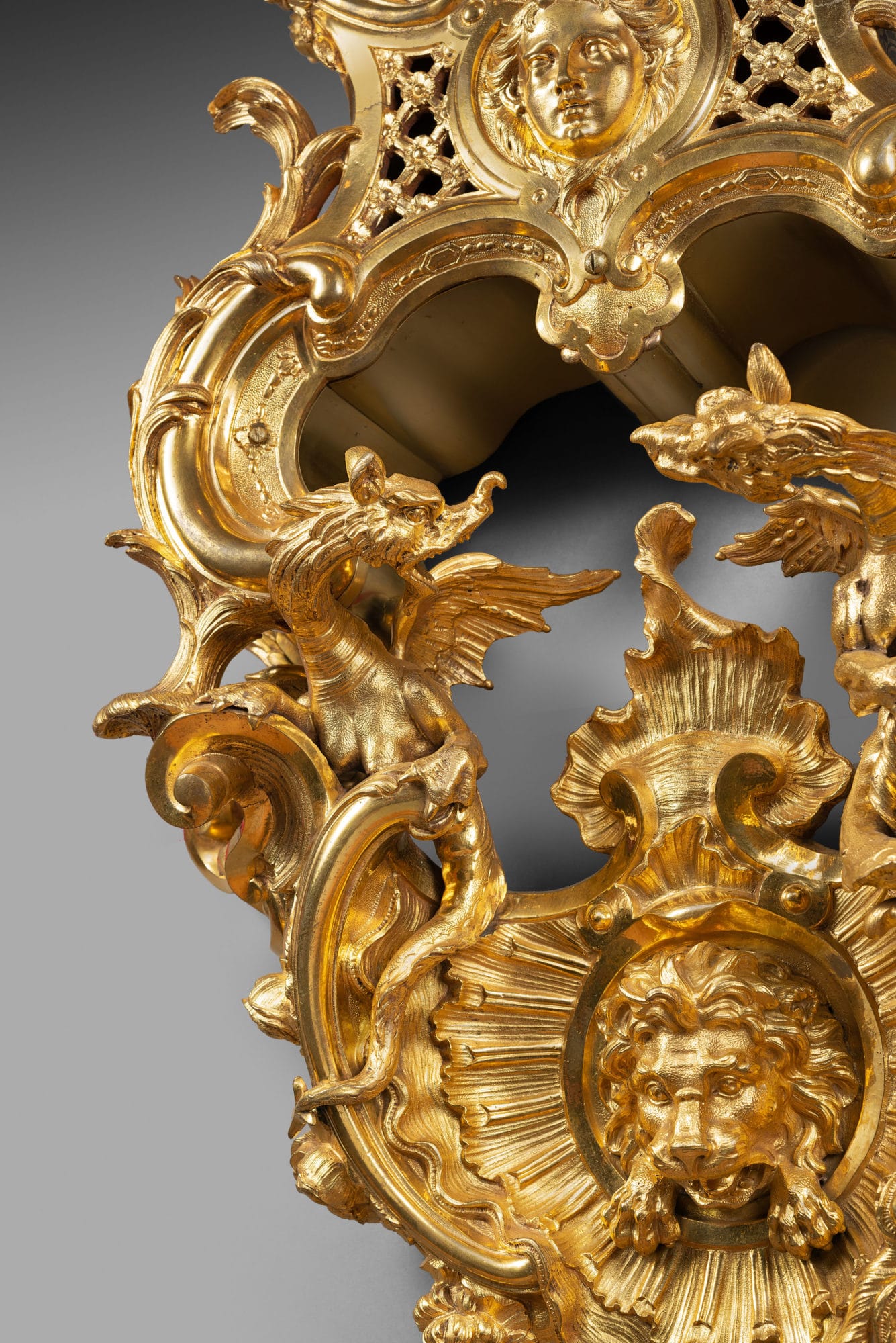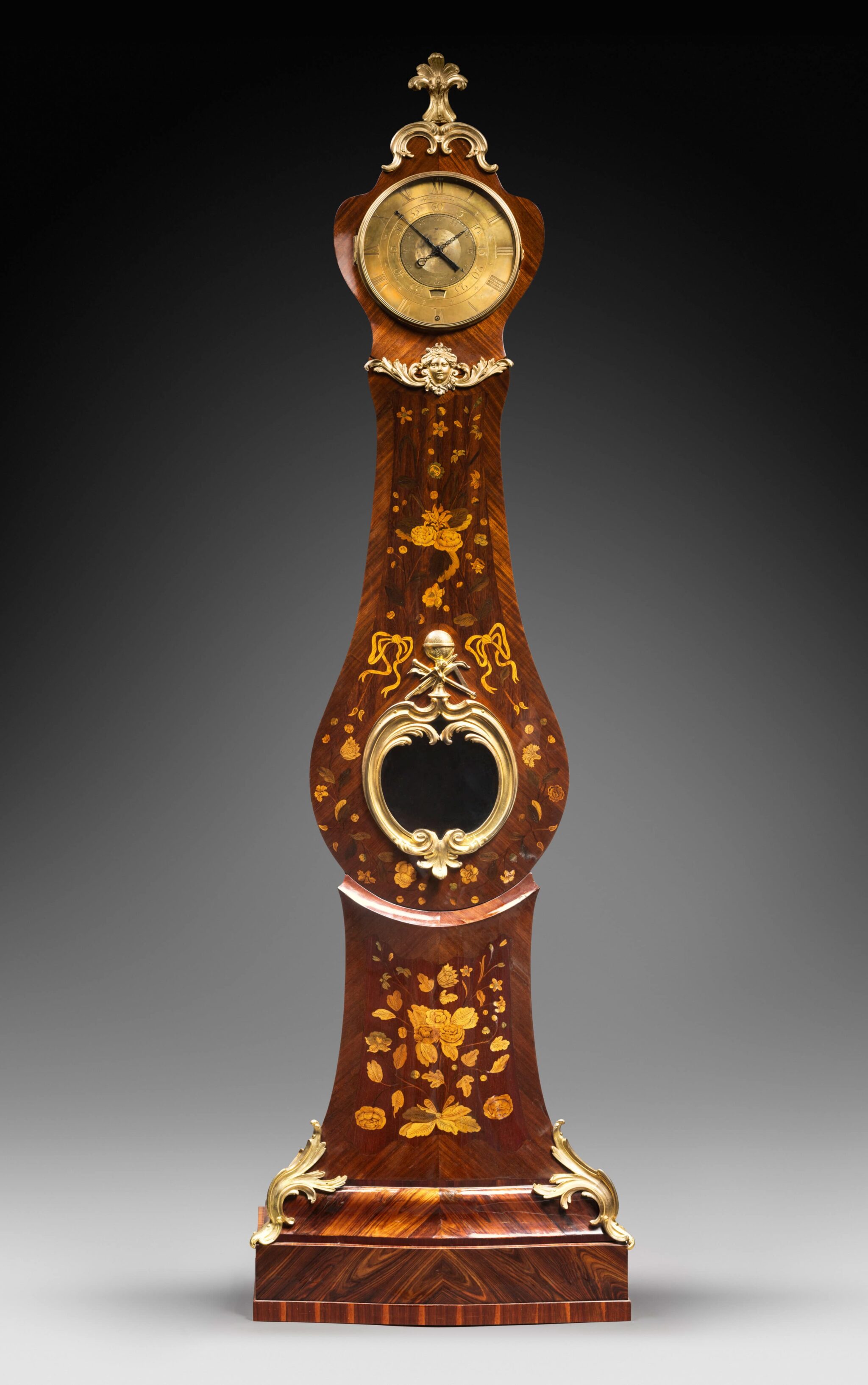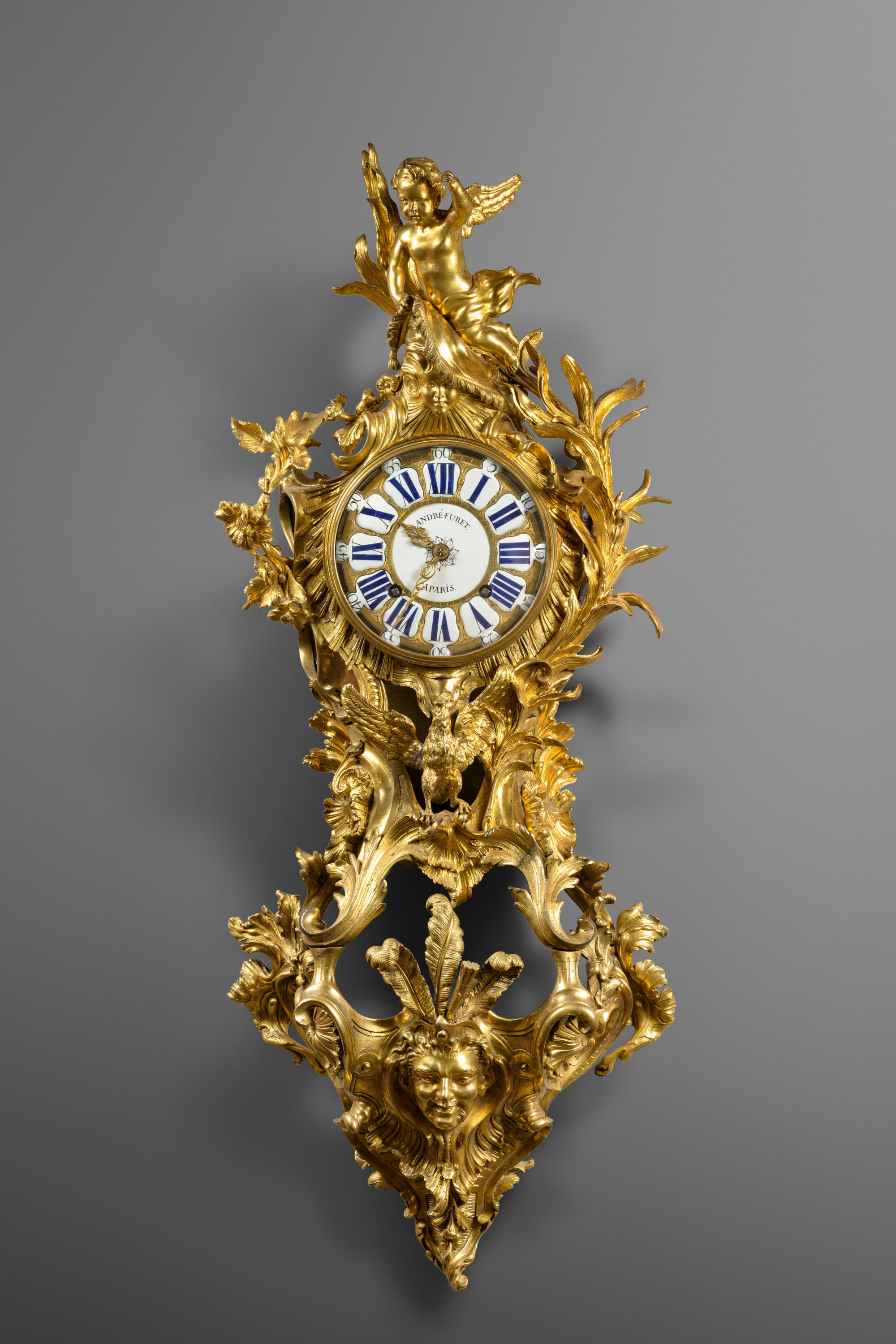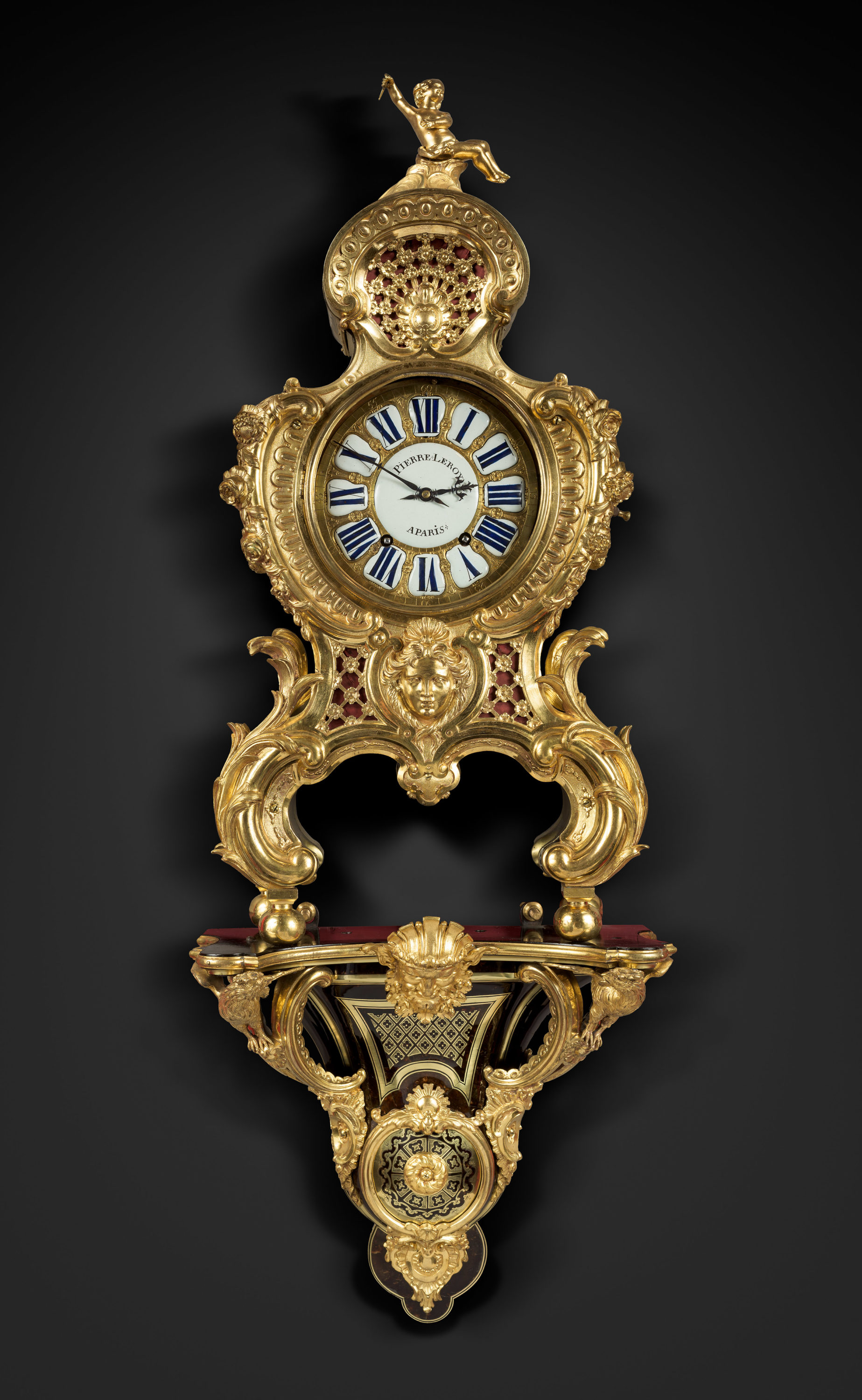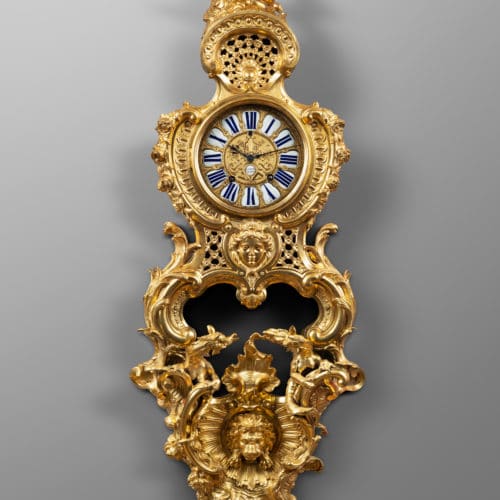Exceptional Boulle Marquetry Rococo Wall Cartel and Bracket in Gilt Bronze and Brass on Tortoiseshell
Cartel with Female Mask, Premier modèle
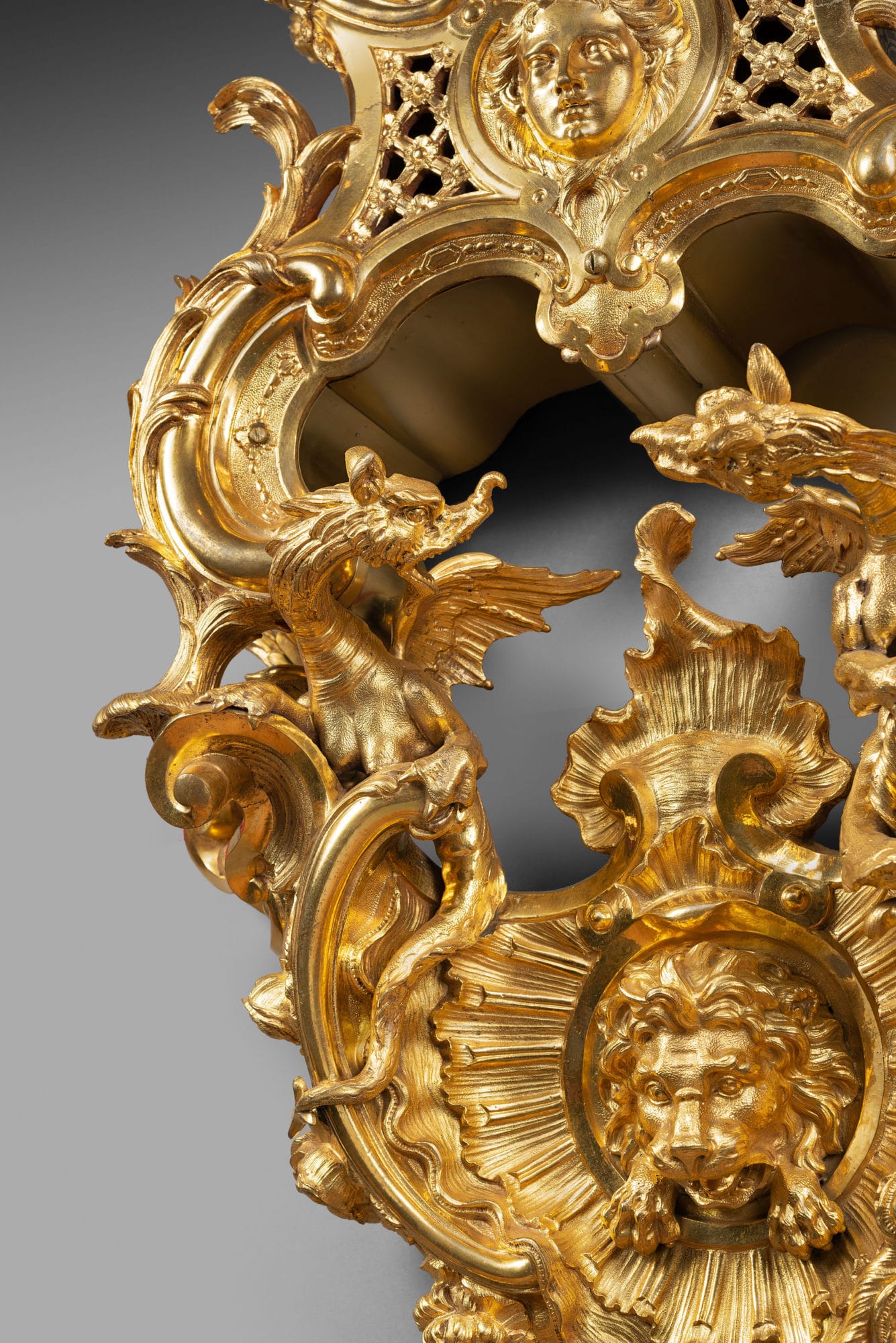
Case by Charles Cressent
Paris, early Louis XV period, circa 1730
Provenance:
– Formerly, collection of the Marquis de D… sold Paris, Galerie Georges Petit, June 17, 1921, lot 91
– Sold Paris, Maître, Galerie Charpentier, le March 24, 1955, lot 75
– Private collection, Périgord (France)
The round copper dial, adorned with delicately engraved motifs, is signed “Guiot à Paris” in a round enamel cartouche. It indicates the Roman numeral hours on twelve enamel cartouches and the five-minute intervals along its outermost border, by means of two polished steel hands. The waisted case is made of finely chased gilt bronze. The clock is surmounted by a lightly draped putto figure that is seated among the clouds and extends his arms to his right. He rests upon an arched capital that is embellished by a cabochon-centered interlace frieze that terminates in volutes and contains a pierced decoration with flower blossoms radiating outward from a large, stylized flower. The movement, also signed “Guiot à Paris”, is flanked by C-scrolls adorned with gadrooned friezes and flower and leaf swags, which extend downward to the four curved feet that are decorated with wide applied palm leaves, which rest upon quadrangular entablatures supported on spheres. Underneath the dial, a magnificent female mask whose tresses are tied under her chin, surmounts a three-lobed motif with a shell that emerges from a C-scroll decorated cartouche; it is surrounded by latticework motifs centered by flowers. The sides of the case are of Boulle metal marquetry and feature engraved brass motifs on a colored tortoiseshell ground. The clock rests on a bracket that is also made of finely chased bronze and features rococo motifs including large asymmetric shells, leaves, C-scrolls, volutes, crouching winged dragons, and sunflowers. The bracket terminates with a shell motif; it is centered by a large rococo motif with a medallion from which a lion is about to spring.
Discover our entire collection of luxury antique cartel clocks for sale online or at the gallery.
In the mid 1730s, Charles Cressent created a type of very elaborate cartel that became one of his most successful models. The design features palm feet adorned with flowers and a female mask with a shell headdress flanked by pierced latticework motifs. Alexandre Pradère, who has closely analyzed Cressent’s work, has called this style “premier modèle”. Later, the cabinetmaker-sculptor revised the style, working in a rococo manner that was called “second modèle”, which was adopted several decades later by Saint-Germain (see Charles Cressent, sculpteur, ébéniste du Régent, Dijon, 2003, p. 176-183). Here, we are concerned with the “premier modèle”, which is that of the present clock. It became a huge success among collectors of the time, and Cressent produced several variations of it, which were designed to be placed on brackets. Three main variations are recognized.
The first type of bracket is centered by a mask of Boreas blowing on feathers. One example of this model is known, whose movement is signed “Etienne Lenoir”; it was formerly in the collection of Farmer-General Marin de la Haye, and is today in the Musée Condé in Chantilly (see Anne Forray-Carlier, Le mobilier du château de Chantilly, Editions Faton, Dijon, 2010, p. 49, catalogue n° 7). A second example was acquired at auction in 1975 by the Musée national du château de Versailles (illustrated in Pierre Verlet, Les bronzes dorés français du XVIIIe siècle, Paris, 1999, p. 283, fig. 315). This might well be the clock that was delivered to the Château de Versailles in February 1745 by the clockmaker Jean-Baptiste Baillon for the chamber of the Infanta Maria Theresa Rafaela of Spain, the wife of the French Dauphin. The clock was described as follows in the Journal du Garde-meuble de la Couronne: “N°42. A lovely gilt bronze ormolu clock made by Jean-Baptiste Baillon, whose dial is of enamel and whose hands are gilt bronze, supported by two consoles accompanied by palms, in the center of which is a female mask: on the sides there are ornaments of mosaic and two flower bouquets: the summit is crowned by a Cupid holding a scythe in his hand: the bracket is also of gilt bronze, embellished with shells, flowers, feathers, two dragons and a mask of Boreas, the height is 4 pieds and the bracket is 14 pouces wide.” (Archives Nationales, Maison du Roi, Série O/1/3313, folio 172).
The second type of bracket is less common; only three examples are known. The first of these, now lacking its movement, and featuring a bearded satyr mask, is in the Musée des arts décoratifs à Paris, Larcade bequest of 1938 (illustrated in Alexandre Pradère, Charles Cressent, sculpteur, ébéniste du Régent, Editions Faton, Dijon, 2003, p. 180, catalogue n° 202B). A second clock, which formerly belonged to the Groves Foundation, is in the Minneapolis Institute of Art (illustrated in J-D. Augarde, “Jean-Joseph de Saint-Germain bronzier (1719-1791), Inédits sur sa vie et son œuvre”, in L’Estampille/L’Objet d’art, n°308, December 1996, p. 69, fig. 9).
The third type, which features a lion that appears to emerge from stylized motifs, is the same model as the present clock, and appears to be the oldest, stylistically. Four examples of this type are known today, among which one is in the Musée des Arts décoratifs in Paris (see H. Ottomeyer and P. Pröschel, Vergoldete Bronzen, Die Bronzearbeiten des Spätbarock und Klassizismus, Band I, Munich, 1986, p. 79, fig. 1.12.6). A second is in the Musée du Louvre in Paris (see D. Alcouffe, A. Dion-Tenenbaum and G. Mabille, Les bronzes d’ameublement du Louvre, Dijon, p. 68, catalogue n° 29). A further version of this bracket, in which the lion is replaced by a rooster, is known (see T. Dell, “The gilt bronze cartel Clocks of Charles Cressent”, in Burlington Magazine, April 1967, p. 213, fig. 36).
André-Georges Guiot (also spelled Guyot) was one of the finest Parisian clockmakers of the Regency period and the early years of the reign of Louis XV. Little is known about his career; it is possible that he worked in Paris for only a short time before moving to the provinces. His work has, however, been very well documented, for he was close to cabinetmaker and sculptor Charles Cressent, for whom he produced many clock movements. Through Cressent’s intermediary Guyot took part in furnishing the homes of the greatest collectors of the early part of the 18th century; several clocks bearing his name were mentioned at the time as belonging to important Parisian connoisseurs. Among them are those described as being in the home of the widow of Olivier du Couedic de Kerdrain, contrôleur de l’Ordre royal de Saint-Louis, in that of Nicolas Judde de Grainville, Grand Maître des eaux et forêts de Soissons, and of Henry-Louis de Barberie de Saint-Contest, intendant de Limoges, as well as in the homes of Antoine-Gaspard Grimod de la Reynière and Charles Savalette de Magnanville.
Discover our entire collection of rare clocks on La Pendulerie Paris.
Charles Cressent (1685 - 1768)
Charles Cressent is one of the most important Parisian cabinetmakers of the 18th century, and probably the most famous furniture maker working in the Regence style, which inspired his furniture and sculpture throughout his career. The son of a sculptor to the king, he studied sculpture in Amiens, where his grandfather resided – his grandfather was himself a sculptor and furniture maker. He initially trained as a sculptor and became a member of the Académie de Saint Luc in 1714, presenting a piece in that category. He then settled in Paris and began to work for several of his colleagues, and married the widow of cabinetmaker Joseph Poitou, formerly the cabinetmaker to Duke Philippe d’Orléans, then the Regent. By dint of this marriage, he became head of the workshop and continued its activities so successfully that he, in turn, became the official supplier to the Regent, and upon the Regent’s death in 1723, his son Louis d’Orléans continued to give commissions, thus insuring Cressent’s continued prosperity during those years. His fame quickly spread beyond the kingdom’s frontiers, as several European princes and kings commissioned pieces from Cressent, among them King John V of Portugal and Elector Charles Albert of Bavaria. In France, he had a private clientele that included members of the aristocracy such as the Duke de Richelieu and important collectors, such as the influential Treasurer General of the Navy Marcellin de Selle. Throughout his career, Cressent created his own bronze mounts that were cast in his workshop, which was against the rules of the bronze casters’ guild, as did André-Charles Boulle. This gave his work a great deal of homogeneity and highlighted his extraordinary talents as a sculptor.
